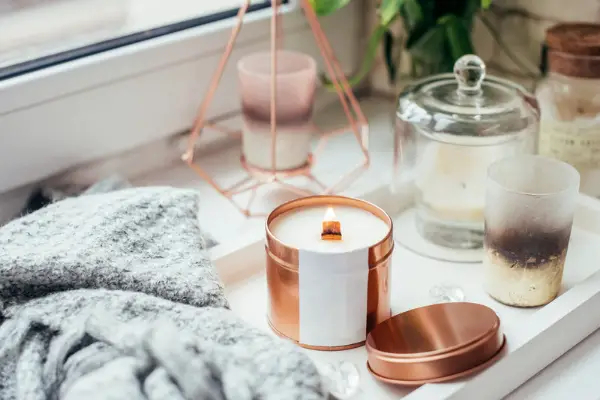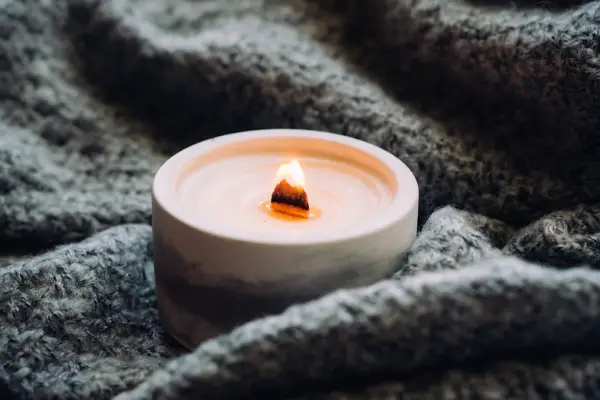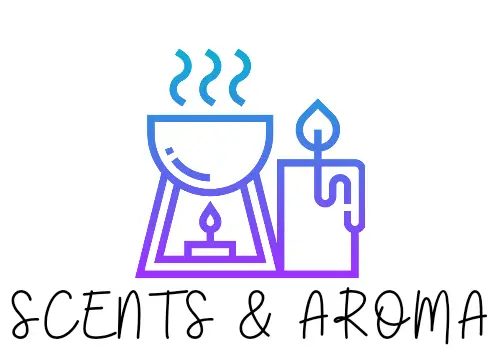Wooden wicks haven’t been around all that long, perhaps half a decade, but wood wicks vs cotton wicks for candles has become somewhat of a hot topic.
So, if you’re wondering about wood wicks vs cotton wicks for candles – which is best? The short answer is: It depends on where you are planning to burn your candle! If you’re burning candles outdoors, you’ll struggle with wooden wicks, but if you want a great scent throw inside, wood is the best choice. Cotton wicks seem to make the perfect around candle wicks.
The rest of this article will outline the differences between the two and go over which type of wick is best for different types of candles.

What are wood wicks made from?
Wood wicks are either tubes or thin slabs of wood that are made for candles. Unlike cotton wicks, these create lovely crackling sounds, but they need slightly more maintenance and attention.
When most people talk about wood candle wicks, they think of the single-ply, flat wick. However, three factors describe these types of wood wick:
- Their crackle type – are they a ‘whisper’ (quieter burning) or ‘crackling’ (louder burning)?
- Their thickness – this usually ranges between 0.02” and 0.04”
- Their width – this usually ranges between 0.375” and 0.75”
These single-ply wicks will perform best in candle waxes that aren’t natural – in other words paraffin, or others. The reason for this is that the majority of natural waxes will struggle to burn consistently unless they have a booster strip. A booster strip is an additional wooden strip that is placed down the middle of the wick.
Another type of wood wick is a spiral wick. Spiral wicks are like cotton wicks without a core. Essentially, these are just a piece of wood that has been moulded into a spiral shape.
Since wood isn’t uniform, there will be variations between wicks from batch to batch.
What are cotton wicks made from?
Cotton wicks are made from braided strands of cotton. These are compressed and dipped in wax so that they hold their shape. Usually, cotton wicks are cheaper, and they are easier to maintain compared to wood wicks.
Typically, cotton wicks are braided flat so that they curl into the flame and are self-consuming. This means they don’t need to be trimmed. Before these wicks were introduced, people needed to trim their candle wicks with special scissors.
Sometimes, cotton candle wicks have a stiffener inside to make them more rigid and let the wick stand further out of the molten wax. Stiffeners are made from fine wire, like copper. These used to be lead, but this has now been banned due to concerns of lead poisoning. Other stiffeners include synthetic fibres and paper.
Cotton wicks are normally pre-treated with a flame-resistant solution. This process is called mordanting. Without being pre-treated, the wick would be burned quickly by the flame. Sometimes wicks are pre-treated with other substances like salt and borax to improve their flame colour and brightness.

Which wick type burns the cleanest?
As far as igniting goes, both cotton wicks and wood wicks are easy to light on their first lighting. Wooden wicks, though, are a bit more challenging to relight on subsequent burnings and need much more time and care. They can take up to twenty seconds to light.
To combat this problem, some candle makers glue multiple wood wicks to make a multi-ply wick. Other companies soak their wooden wicks with accelerants to make the flame stay. Unfortunately, this means that you need to be careful because it is difficult to know whether the accelerant or glue is safe to breathe when it is burned with the candle.
The fact is that both types of wick can burn cleanly if you choose the right ones. Look for a wick that is a single-ply wood wick or a cotton wick that is 100% cotton.
Choosing to burn sustainable and eco friendly candles comes down to wax choice as well. Why not take a look at my guide to which wax is the best for your candles.
Are wood wicks or cotton wicks toxic?
Provided you buy 100% cotton or single-ply wood wicks, both will burn without toxins being released. However, the type of wax used is really important. Non-natural waxes like paraffin contain harmful toxins and carcinogens.
Wood wicks do burn more cleanly than cotton wicks, but this is because cotton wicks can contain heavy metals like lead and are often treated with chemicals to slow down their burning.
Which wick is the best for candles and why?
The answer to this depends largely on what the candle will be used for and where it will be used. It is not recommended to use wooden wicks outdoors or where there is a draft. This is because they are much more likely to blow out with even a gentle breeze. And, once they’ve blown out, they’re much more difficult to get relit.
Outdoors, cotton candle wicks fare much better, but they still struggle and can be erratic and burn more quickly.
If you’re burning indoors, you will find that wooden wicks have an improved scent throw compared to cotton wicks. This is probably because the wick burns lower. With a low, smoldering wick, the wax warms up around the wick instead of being burned quickly.
Cotton wick candles have taller flames, which means they quickly burn the fragrance out of the candle wax. With a cotton wick, your candle has an intense burn and subsequent burns appear to be less scented.
Wicks made out of wood have a horizontal, lower flame that gives your candle more heat quickly. So, despite burning lower and slower, this wick heats up fragrances to throw the scent in less time.
Final thoughts and conclusion
The purity and depth of a wooden wick scent throw makes this type of wick worth it. With this, you have the crackling, horizontal flame, which is great. Provided you’re able to get on with them in the right conditions and environment, wood wicks are a sustainable and environmentally-friendly candlewick material.
With wooden wicks, it’s important to source ones that haven’t been glued or altered in any way with chemicals. This is because you can’t know for sure that there aren’t any toxic chemicals used.
Cotton wicks certainly have their place in the candle world still, and they’re great for many reasons, including their use outdoors – which wooden wicks struggle with.
The type of candlewick should never be the only consideration when choosing a candle. You also need to consider the type of wax used, especially if you are worried about toxins and carcinogens. For example, paraffin is particularly harmful to burn, but this is often paired with wooden wicks because other wicks don’t work as well.
When choosing your candle, you should consider the following attributes:
- Is it a natural wax-like coconut, palm or soy wax?
- Is the candle phthalate-free?
- Is it non-toxic?
- If the wick is cotton, is it lead-free and zinc-free?
If you’re unsure which wick you want to go for, consider getting a similar candle of each to compare how they work and last. There is a lot to consider, with each wick type having its own drawbacks and benefits. Ultimately, there isn’t a wrong or right answer, you just need to compare both and see which you prefer.
- Can You Put Perfume In A Humidifier? (Read First) - September 17, 2022
- Can You Put Essential Oil In A Steam Mop? (Safety Advice) - September 17, 2022
- How To Make Lavender Oil At Home ( Candles And Diffusers) - September 9, 2022

